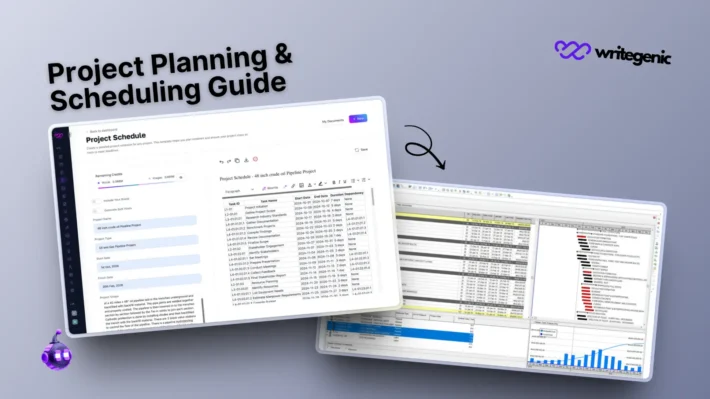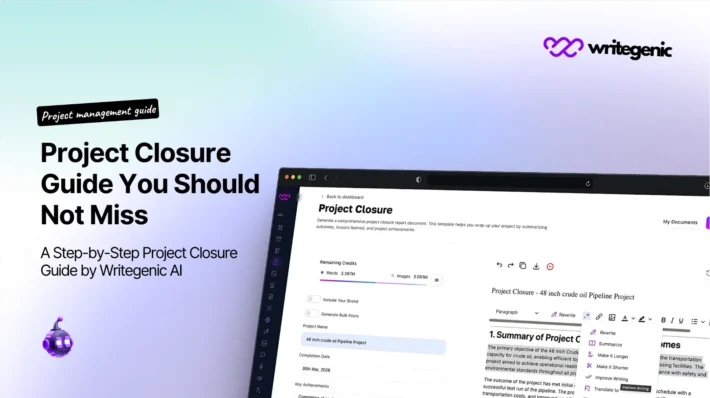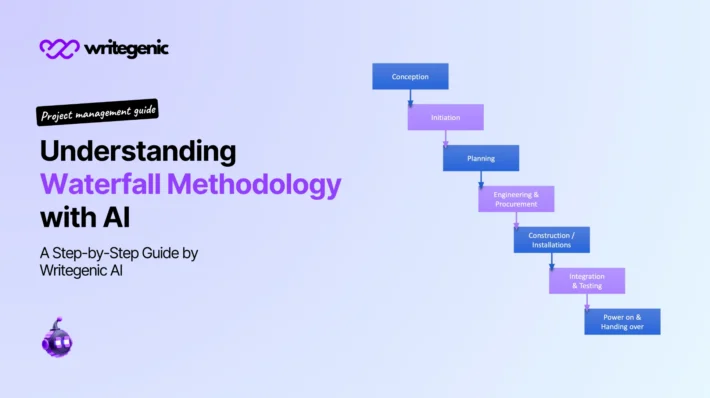Creating a Successful Project Execution Plan Step-by-Step
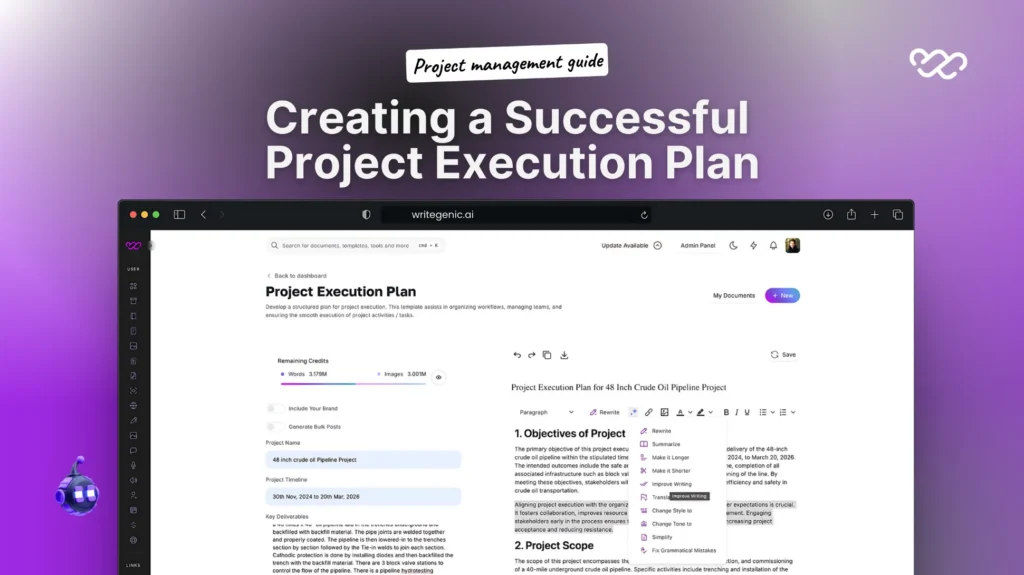
The modern business environment demands a clear project execution plan, in which the key issue is to maximize the delivery of projects on time, at their cost and at the desired level of quality. It helps the team to run the phase of project management implementation and keep all operational gears in line with the broader aim.
Having a good execution plan means the difference between success and failure, whether you are introducing a new software product or developing infrastructure.
Table of Contents
What Is a Project Execution Plan?
Project execution plan (PEP) is an official document describing the process of the project execution, monitoring, and control. It integrates all the important aspects including goals, deliverables, schedules, roles, communication techniques and risk management techniques.
In an in-depth consideration of the topic of project management and execution, the implementation plan is the play book that converts the strategy of a project into steps. It helps close the gap between planning and performance, and can outline the responsibilities of each stakeholder rest assured.
Importance of a Project Management Execution Plan
Project management execution plan is not only a document but an important instrument leading to actual implementation. This is why it is important:
Alignment:
Maintains the different stakeholders on the same page by spelling out expectations and responsibilities.
Clarity:
Helps prevent misunderstanding by providing details about specific tasks, schedules, and deliverables.
Efficiency:
Eliminates wastes, simplifies organization and maximizes the use of resources.
Risk Reduction:
Identifies the issues that may arise and presents a mitigation plan.
Accountability:
Makes it possible to monitor the advances and makes each of the team members responsible towards his/ her tasks.
Even with the best intentions, any project that is poorly planned is likely to collapse during implementation because of a lack of communication, scope creep, and resource mishandling.
Key Components of a Project Execution Plan
A project implementation strategy normally has the following components:
- Project Objectives & Deliverables: The clear project statements of what the project should deliver as to what it seeks to achieve.
- Roles & Responsibilities: This is where important people in the team were identified, their responsibilities as well so that there are obligations.
- Timeline & Milestones: An elaborate timeline which contains segments, activities, and milestones.
- Communication Plan: A plan that includes frequent updates, reporting, and communication with stakeholders.
- Quality Control: Measures and criteria applied to guarantee the completeness of the deliverables with the expected specifications.
- Risk Management Strategy: A strategy involving identification, assessment, and mitigation of risks.
- Resource Planning: Allocation of human, financial, and material resources required to execute.
All these factors make the project management execution plan to be realistic and provide direction to the project attaining the objectives.
Step-by-Step Guide to Creating a Project Execution Plan
Follow these steps to develop your own project execution plan:
Step 1: Define Project Objectives and Scope
Begin by creating a description of the task to be achieved and what is not or is in the scope of the project. This contrasts with clarity eliminating scope creep and confusion in the future.
Step 2: Identify Stakeholders and Assign Roles
Identify all the stakeholders including the end users. Deploy roles and responsibilities to make them accountable during the implementation process.
Step 3: Develop the Project Schedule
Divide the project into phases, tasks, and milestones. To visualize the timeline and dependencies use tools such as the Gantt charts or Agile sprints.
Step 4: Plan Resources and Budget
Identify the manpower, technology, equipment, and money that is needed. Make sure that there will be allocations that are according to availability and limitations.
Step 5: Establish Communication and Reporting Guidelines
Establish a schedule of meetings to discuss the performance, reports, and loops of the status. Communication brings about clarity and removes delays.
Step 6: Create a Risk Management Plan
Identify the possible risks, their probability, consequences, and prevention measures. The project requires proactive risk planning to stabilize itself.
Step 7: Finalize and Approve the Execution Plan
Discuss the plan with major stakeholders. Develop feedback and have formal concurrence to enter into the project management implementation stage.
Creating a Perfect Execution Plan Using Writegenic AI in Minutes
To get rid of all the headaches of manually typing a whole document, we have solved this problem of creating a project execution plan with the help of specially trained Writegenic AI.
You can now create a successful project execution plan in minutes using this tool. Just enter project details, or toggle your brand voice (Project-specific), click a generate button, and you have your perfect execution plan ready in minutes. It is like a magic.
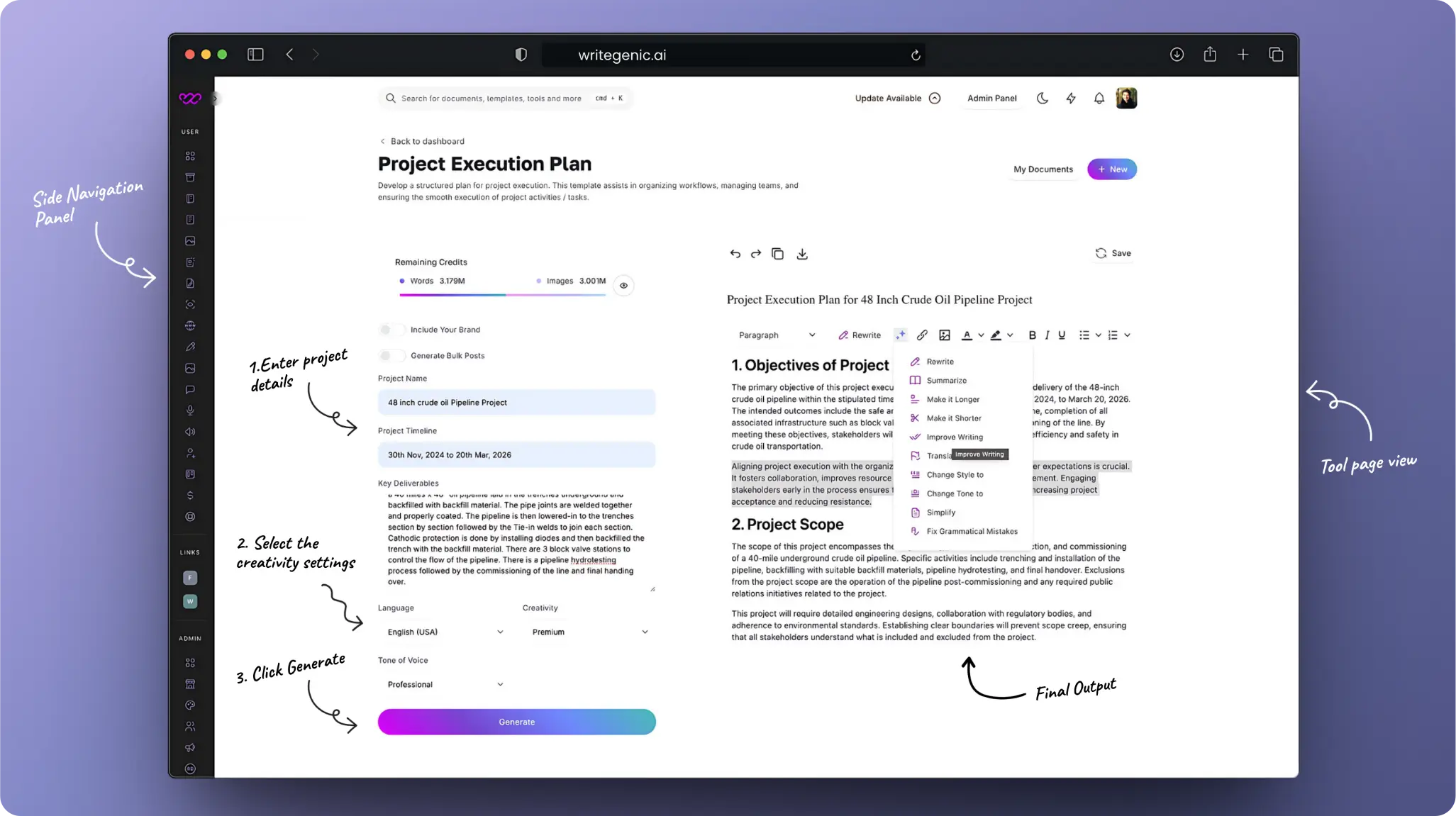
Understanding the Project Management Execution Phase
The execution phase is when planning becomes action. Teams start to create project results according to the plan provided in the PEP. The following is part of this stage:
- Coordinating people and resources
- Managing stakeholder expectations
- Tracking deliverables and timelines
- Addressing issues as they arise
This phase should also be very successful depending on the effectiveness with which the project management execution plan had been put on. It is uniform and minimizes doubt and quality is maintained all throughout.
Tools for Project Execution Planning
Leverage digital tools to streamline your planning and execution:
Top Tools
- Asana – Task management and team collaboration
- Writegenic AI – AI assistant for quick, professional project documents
- MS Project – Detailed scheduling and resource management
- ClickUp – All-in-one workspace for planning, docs, and tracking
- Wrike – Agile-friendly project tracking and reporting
Conclusion
Any project that does not have an implementation plan is a ship without a compass. The management and implementation of the project lies on a systematic process, free communication, and consistent supervision. With a comprehensive plan, teams can work with confidence and achieve their targets and earn stakeholder trust.
When you fail to take the time to develop a comprehensive project execution plan, then you can bet your bottom dollar that you will never succeed in project implementation.
Frequently Asked Questions
What is a project execution plan in project management?
A project execution plan documents the way in which a project will be executed, directed and controlled. It outlines roles, dates, deliverables and communication procedures.
What is the project management execution phase?
This is the stage of working, but according to the plan. It entails performance of tasks, organization of resources, quality control, and communication with the parties.
Can small teams benefit from a project execution plan?
Absolutely. Having structure and clearness is also useful even in small teams. A simplified implementation process assists in enhancing responsibilities, delicacy and concentration.
What is the difference between a project plan and a project execution plan?
Project plan is a high level document which contains scope, cost, schedule, and life cycle of a project. A project execution plan targets the methodology of the execution phase, namely: defining duties, products (deliverables), information flow and risk management in the execution process.
How to create a project execution plan using Writegenic AI?
Step 1: Open the template from Writegenic AI’s dashboard under the “AI writer” section.
Step 2: Enter your project details.
Step 3: Select creativity levels, and click “Generate”.
In 3 easy steps, your perfect project execution plan is generated in minutes.
